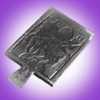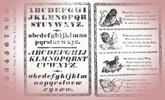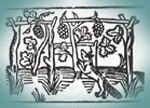


TOWARDS DIGITAL STORYTELLING FOR CHILDREN
THE EVOLUTION OF STORYTELLING FROM THE MIDDLE AGES
- Middle Ages - Oral Tradition
- 1400-1500's - Instruction
- 1600's - Enjoyable Learning
- 1700's - Introduction of Adventure
- 1800's - Storytelling that Delights
- 1900's - Too Much, Too Fast
- 1970's - Multimedia Mix
Links
Links will be provided for key words and ideas in the essay. They are marked with an asterisk in the text but can only be accessed from the link column.
Hornbook
Battledore
Aesop's Fables
1400-1500's: Hornbooks, Battledores--Books of Instruction
With the development of the printing press, printed information became readily available. The new technology was embraced by a population eager for new experiences. The dark ages were over. The Renaissance, a new age of learning and science, heralded a preoccupation with learning and accomplishment. Parents wanted their children to learn and better themselves in the world. Printed materials were the new medium of learning. (Though we suffered no recent dark ages, our population fairly leaps at each new technology and we too, are preoccupied with learning and betterment.)
Prior to the 1700's, books for children were serious, straightforward, and meant to improve behavior or provide factual information. Following closely on pre-print manuscript tradition, they consisted of ABC's, primers, books of courtesy and catechisms. Little effort was made to accommodate materials to the understanding of children or to develop stories, which appealed to emotions or imagination.

The hornbook* was introduced in the 1400's and enjoyed wide distribution. It consisted of a single sheet of parchment pasted on a small, thin, wooden board shaped like a paddle and covered with a sheet of transparent horn to protect it. Typical contents would be the alphabet and the Lord's Prayer. Children used it to learn to read.
The battledore*, which consisted of three panels that folded in on themselves, eventually displaced the hornbook. It was originally made out of wood with parchment glued to the flaps, but in time came to be made of stiff cardboard. It contained more information than the hornbook: the alphabet, moralistic verses, descriptions of animals, places and people, and many illustrations. The format of the battledore was used for The Royal Primer which was commissioned by the King to promote literacy in England and was widely distributed (Demers & Moyles 3).


In all these print materials, illustrations accompanied text. Illustrations provided the imagery, familiarity, and immediacy important for a young audience which was largely illiterate and unfamiliar with the printed word.
Literary development was in its infancy. The types of books Caxton chose to print, their form, and their content, had a major impact on narrative as it was developing. How one individual can influence the direction of culture is further demonstrated by looking at his editing of Malory's Morte d'Arthur. The stories Malory had written while in prison were written independent of each other. Caxton took them and made one narrative. He believed there would be a better audience for a book with one rather than several stories (Meigs 27). (In the interest of exploring the concept, a comparison can be made between his (a printer's) influence on book narrative development, and computer technicians (as software developers) influence on digital narrative development. Both professions are technology and market driven.)